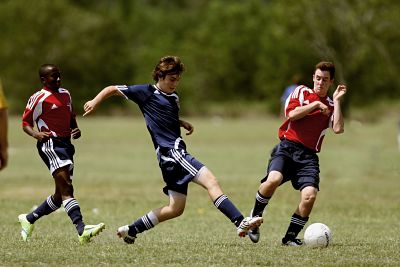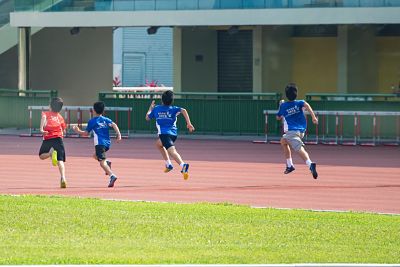We’re regularly asked by parents and coaches whether Precision Fuel & Hydration electrolyte drinks can be used safely by younger athletes.
The answer is yes but context is key.
It’s important to appreciate that there are big differences in the hydration needs of an aspiring youth athlete who’s approaching full physical maturity compared to a young child who simply takes part in recreational sport for fun.
‘Youth athlete’ or a ‘child playing sport’? The key differences
These days, the lines between youth and adult athletes are more blurred than ever. For example, world-renowned gymnast Simone Biles was just 16 when she won her first Olympic gold medal at Rio in 2016 and 16-year-old Harvey Elliot made history for being the youngest ever Premier League soccer player when he made his debut for Liverpool during the 2019/20 season. Then there’s Coco Gauff, the female American tennis player who burst onto the scene as a 15-year-old when she knocked Venus Williams out of the first round of Wimbledon in 2019.
These up-and-coming ‘youth athletes’ are still well below the legal age to get a driving licence or go to a bar in most countries but are already going toe-to-toe with more experienced, world-class opponents and winning.
It’s safe to assume that to compete at a world-class level these guys and girls will be training for a similar duration and intensity as their older peers, as are many thousands of others who are attempting to make a similar breakthrough into the top tier of sport.

The training intensity and competitiveness associated with youth sport in general has increased substantially over the last few decades, so much so that the psychological and physiological impact of early specialization in youth sport is now heavily researched and raises some tough questions around just how healthy this early specialization is.
But that’s a furious debate well beyond the scope of this particular article!
What is clear is that many of these top tier youth athletes will benefit from taking a strategic and scientific approach to many aspects of their preparation - including hydration - but the same is not true for younger children who are participating in sport for fun and fitness alone.
When will a young athlete benefit from a hydration strategy and / or electrolytes?
If we consider the younger end of the spectrum to start with, many children start participating in organised sports around the same time that they begin formal schooling (i.e. typically around 4-6 years of age).
For these very young (pre-pubescent) kids, simply making sure they have access to water to drink and that they’re encouraged to take regular breaks to drink as they feel they need to will be enough to keep them adequately hydrated.

In fact, research with children as old as 12 and 13 points to the fact that a drinking ‘water to thirst’ strategy is all that’s needed to keep their hydration levels adequately topped up.
For example, a study conducted by Dr. Michael Bergeron (President and Chief Executive Officer of Youth Sport of the Americas) showed that one hour of rest and rehydration following 80 minutes of strenuous soccer was generally effective at eliminating dehydration in healthy, competitive children of this age group.
This line of thinking is echoed in the recommendations of Jim White, spokesman of the American Academy of Nutrition and Dietetics:
A balanced diet that includes sodium, in conjunction with plain water for rehydrating, should allow for optimal athletic functioning in children without the need for extra sports drinks.
However, as they grow and start to take their activities more seriously, the ‘child playing sport’ crosses over into the territory of being a competitive ‘youth athlete’. It’s at this point where they may begin to benefit from replacing sweat losses with more than water alone before, during or after training sessions and competitions.
Do youth athletes need a hydration strategy?
Whilst the exact crossover point when this transition from ‘child playing sport’ to ‘youth athlete’ occurs is impossible to define with any level of precision, there are 5 main factors for parents, coaches and the athlete to account for when considering introducing a hydration strategy and electrolytes...
1. Biological Age
Biological age is the degree of physical, mental, cognitive and emotional maturity of a person, rather than just how many years they’ve been alive.
When it comes to hydration, the physical maturity of the youth athlete is important because of the effect it has on sweat rate.
On average, puberty occurs at around age 11 for girls and 12 for boys, but some children mature earlier or later than their peers and hit puberty at different times. Puberty results in a significant increase in overall sweat rates as sweat gland activity increases during this time.
Therefore, it goes without saying that this will clearly exert a strong influence on whether hydration supplements will be beneficial or not.
2. Sweat sodium concentration
Sweat electrolyte concentrations (in particular sodium) show a large variation within the normal population - from as little as ~200 milligrams of sodium per litre (mg/L) of sweat to >2,000 mg/L in some individuals. It’s a measure of how ‘salty’ an athlete’s sweat is and is the key factor that our Sweat Test seeks to identify.
An individual’s sweat sodium concentration is largely genetically determined and it remains relatively stable throughout life, showing only a relatively small increase with age up until adulthood.
Like adult athletes, youth athletes with ‘saltier’ sweat are more likely to benefit from electrolyte supplementation than those whose sweat is more dilute.
Therefore, taking a Sweat Test to evaluate sodium loss in sweat is potentially a very good idea for serious youth athletes post-puberty, especially if they’ve exhibited any of the classic signs of dehydration, hyponatremia or salt-loss in the past.
3. Training Load
An athlete with a demanding training load is more likely to accumulate high sweat losses compared to one who’s only participating in sport a few times a week. Therefore, the duration, intensity and overall volume of the training should be considered when thinking about their fluid and sodium needs.
A youth athlete who’s training at a high intensity and / or for long periods is more likely to be losing fluids through sweating and respiratory losses, and will have a greater need for structured hydration and rehydration.
In our experience, sports that exert higher training demands on youth athletes are those such as swimming and tennis where early specialization seems to be particularly prevalent for those who want to make it to a high level (whether this is right or wrong is a topic of conversation for another blog).
It’s worth bearing in mind that young athletes who are playing multiple sports on different days of the week can also accumulate a significant amount of training time each week, so it’s not only the ‘early specializers’ who this training load factor might apply to.
4. Environment
As obvious as it is to point out, potential hydration issues are always going to become more apparent in hot and humid conditions. The body’s thermoregulatory system is challenged by the increased saturation of the air and temperature, and sweating is upregulated to try and maintain the body’s core temperature within its normal limits.
It’s in these conditions that plain water alone (which might normally be enough for an athlete in cooler conditions) is less likely to be sufficient. So, introducing a hydration strategy for hot weather might be beneficial.
As parents and coaches, it will be important to recognise the environmental conditions (e.g. changes in the seasons; the first hot weather sessions of the season can be particularly problematic for young athletes) and educate your athlete about their impact.
5. Protective Equipment
Regardless of age, athletes who wear protective equipment during their sport may find that their exercise-heat tolerance is reduced by impeded sweat evaporation (e.g. the protective equipment worn during American Football and ice hockey can impede evaporation).
According to the American Council on Science and Health, from 2000 to 2018 there have been 30 heat-related college football player deaths. While there will have been many factors at play and hydration might not have prevented these deaths, starting a training session or match well hydrated by preloading with a strong electrolyte drink can reduce the strain placed on an athlete.
An example of when a hydration strategy and electrolytes have been beneficial to a young athlete:
A very good example of when a young athlete clearly benefited from taking a scientific approach to hydration practices is highlighted in this 1996 case study written up by Dr. Michael Bergeron:
Heat Cramps During Tennis: A Case Report (Abstract)
A 17-year-old, nationally ranked, male tennis player (AH) had been experiencing heat cramps during tennis match play. His medical history and previous physical exams were unremarkable, and his blood chemistry profiles were normal. On-court evaluation and an analysis of a 3-day dietary record revealed that AH's sweat rate was extensive (2.5 litres per hour) and that his potential daily on-court sweat sodium losses (89.8 mmol per hour of play) could readily exceed his average daily intake of sodium.
The combined effects of excessive and repeated fluid and sodium losses likely predisposed AH to heat cramps during play. AH was ultimately able to eliminate heat cramps during competition and training by increasing his daily dietary intake of sodium.
The tennis player in this example was clearly biologically mature, had a high sweat rate and demanding training regime, so he dramatically benefited from a strategic hydration intervention.
Not all cases with youth athletes will be anything like this extreme or clear cut but it shows the other end of the spectrum from the child athlete who just needs plain water.
Can youth athletes use Precision Fuel & Hydration electrolytes?
Precision Fuel & Hydration products are theoretically suitable for all ages and there aren’t any ingredients which would be of concern if used by youth athletes.
Unlike regular sports drinks, the range of Precision Fuel & Hydration products are all hypotonic - meaning they contain less sugar (either close to zero or <3% carbohydrate solutions, whereas most sports drinks are 6% or more).
For the prepubescent age group, hydration needs can and should largely be catered for by drinking plain water alone because the amount of sweating that small kids do is rarely enough to warrant anything more than that.
That being said, as youth athletes transition through puberty and if they start to train and compete more like adults, their hydration needs may begin to benefit from a more strategic approach that can include Sweat Testing and some electrolyte supplementation if sweat or sodium losses are high. This is especially true when their training and competition environment is hot or humid.
Ultimately, assessing each individual case on its own merits is the most important takeaway.
If you work with a youth athlete and have any questions about personalising their hydration strategy or whether using Precision Fuel & Hydration products with them might be appropriate, then please feel free to contact us by emailing hello@precisionhydration.com or you can book a free one-to-one call with one of our team.
